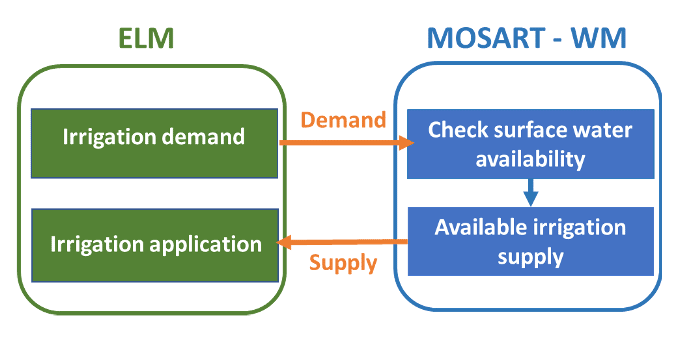River and Reservoir Water Availability Guides Global Irrigation Modeling

Irrigation water originates from diverse sources which have not been well represented in previous Earth system models.
Integrating information on irrigation processes into Earth system models allows for more accurate representation of the global water cycle.
The Science
Irrigation supports agricultural production, but its widespread use can perturb the regional and global water cycles. Given its potentially disruptive nature, simulating the effects of land use and water use in Earth system models requires accurately representing irrigation. Scientists developed a novel method to improve the representation of irrigation processes in the Energy Exascale Earth System Model (E3SM). This new method couples the existing land surface model (ELM) with the river and water management models (MOSART-WM) to dynamically constrain the supply of irrigation water based on the available river and reservoir water (see Figure 1). The new two-way coupled method better represents global groundwater level decline and recharge, while capturing the seasonal dynamics of irrigation water allocations that reflect local water conditions. Constraining the irrigation water supply based on available surface water results in more realistically simulated irrigation efficiency.
The Impact
The two-way coupled irrigation scheme represents an important step to accurately model the interactions between human water use and the global water system. It lays a foundation for future studies aimed at enhancing scientific understanding of how global water resources constrain energy production and use, as well as how socioeconomic decisions, such as land use, influence water resources. Better irrigation representation is key to evaluating the feasibility and impacts of large-scale bioenergy production.
Summary

Figure 1. The newly developed two-way coupled irrigation scheme allows the E3SM Land Model (ELM) and E3SM river and water management models (MOSART-WM) to exchange information for a more dynamic and accurate representation of irrigation. This provides better overall representations of irrigation and its impacts on the water cycle.
This work introduces a major enhancement into E3SM, replacing the one‐way coupled irrigation scheme with a two‐way coupled scheme that better captures the interactions between the irrigation-influencing land, river, and water management models. The two‐way coupling scheme alters the modeled hydrological and irrigation processes in many important ways. First, the surface water constraints in the new coupling scheme result in less surface water withdrawal and less return flow. This reduced surface water withdrawal (by more than 50% in some arid river basins) results in a 5–10% reduction in evapotranspiration and up to a 60% reduction in return flow. Second, constraining the irrigation supply to use only surface water available from rivers and reservoirs in addition to groundwater reduces irrigation water withdrawal by about 30% at a global scale. Third, the two‐way coupled scheme can capture the seasonal dynamics of irrigation water allocations. Groundwater contributes more to global irrigation allocations from February to June, but the monsoon-dominated increase in summer river discharge in major basins shifts the main source of irrigation water to surface water after June.
Publication
- Zhou, T, L Leung, G Leng, N Voisin, H Li, A Craig, T Tesfa, and Y Mao. 2020. “Global Irrigation Characteristics and Effects Simulated by Fully Coupled Land Surface, River, and Water Management Models in E3SM.” Journal of Advances in Modeling Earth Systems 12(10). https://doi.org/10.1029/2020ms002069.
Funding
- The U.S. Department of Energy Office of Science, Biological and Environmental Research supported this research as part of the Earth System Model Development Program Area through the Energy Exascale Earth System Model (E3SM) project.
Contact
- L. Ruby Leung, Pacific Northwest National Laboratory


